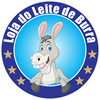Consumo de leite de burro e benefícios para a saúde humana, com referência especial ao estado inflamatório.
Muitas vezes confundido como alergia á lactose aproximadamente 7% da nossa população é alérgica á proteína do leite de vaca.
Donkey Milk contains numerous nutrients. The content of n-3 fatty acids, the n-6/n-3 ratio, and short- and medium-chain fatty acids may promote positive health effects.
Milk is a source of bioactive compounds essential for the health and growth of newborns. Donkey milk, rich in lactose and whey proteins, has been proven to be a good breast milk substitute during infancy and adequate nourishment for patients with cow milk protein allergy.
A progressive decline of immune functions with age and both innate and adaptive immune responses are severely impaired and increase the susceptibility of old people to infections, tumors, and autoimmune diseases.
The legendary cosmetic and therapeutic properties of equine milk are widely known. In fact, Cleopatra, Poppea and other privileged women of ancient times took their baths in donkey’s milk in order to keep their skin fresh and shiny. In addition, Hippocrates, as well as Pliny the Elder, believed that donkey’s milk could act therapeutically in numerous cases, such as liver problems, infectious diseases, fevers, asthma, etc. (Cunsolo et al., 2011).
The antimicrobial activity of donkey milk was examined against 3 bacterial and 3 fungal strains selected on the basis of their relevance as human pathogens. All samples of donkey milk exhibited antimicrobial activity against dermatomycotic fungi and foodborne pathogen bacteria.
Human breast milk is the best nutritional support that ensures the right development and influences the immune status of the newborn infant. .
Donkey’s milk is the best substitute of human milk for its content in lactose, proteins, minerals, and
The diversity of lactic acid bacteria (LAB) species in donkey’s milk was analyzed by culture-dependent microbial techniques. Dominant strains were isolated on agar media generally used for enumerating LAB. To enrich the number of acidifying LAB present, the milk samples were incubated at 37°C for 24 h (cultured milk samples, CM).
Fortification of human milk is standard practice for feeding very low birth weight infants. However, preterm infants often still experience suboptimal growth and feeding intolerance.
Allergy to cow’s milk proteins is one of the most common food allergies in children, and it is estimated that it affects 2 to 5% of the child population under 3 years of age (Huang and Kim, 2012). Symptoms, that can manifest immediately or within a few hours of consumption, can be cutaneous (itching, hives), gastrointestinal (abdominal pains, diarrhea), respiratory (asthma) or even systemic (anaphylaxis).
Among them, donkey’s milk proved to be the best alternative in feeding infants affected by CMPA, since its chemical composition is comparable to human milk. In this work an in vitro study was performed in order to analyze the IgE reactivity to milk protein allergens from cow
Different nutritional components are able, by modulating mitochondrial function and gut microbiota composition, to influence body composition, metabolic homeostasis and inflammatory state. In this study, we aimed to evaluate the effects produced by the supplementation of different milks
Donkey’s milk could be considered suitable for feeding young children affected by
severe IgE-mediated CMPA because its nutritional properties and composition are very close to
human milk.
O leite de burra é também considerado útil na prevenção da aterosclerose e tem a capacidade de regular positivamente a resposta imune de humanos idosos saudáveis.
O leite é uma das causas mais comuns de alergias alimentares em crianças menores de um ano de idade. Não existe terapia específica para essa alergia e, portanto, a única resposta possível é evitar a alimentação de leite e produtos derivados.
A alergia às proteínas do leite de vaca afeta 2-7% das crianças que usam fórmulas de leite de vaca. Cinquenta a oitenta por cento deles desenvolvem alergia a outros itens alimentares e substitutos. O leite de burra, ao contrário, é o mais próximo do leite materno.
A produção de leite de burra e a sua composição química foram investigadas em duas lactações
Vários estudos recentes esclareceram o uso terapêutico do leite de burra (LB) devido à sua composição especial e propriedades nutricionais, muito semelhante ao do leite humano.
Em crianças com alergia às proteínas do leite de vaca (CMPA), quando não é possível amamentar ou usar leite de vaca, o uso clínico do leite de burra é considerado, pois vários estudos demonstraram a alta similaridade do leite de burra em relação ao leite humano.
O consumo de leite de burra e cabra foi reavaliado por seus potenciais benefícios à saúde humana.
Os resultados dos testes com Lactobacillus rhamnosus evidenciaram que o leite de burro é realmente um excelente candidato para bebidas probióticas.
